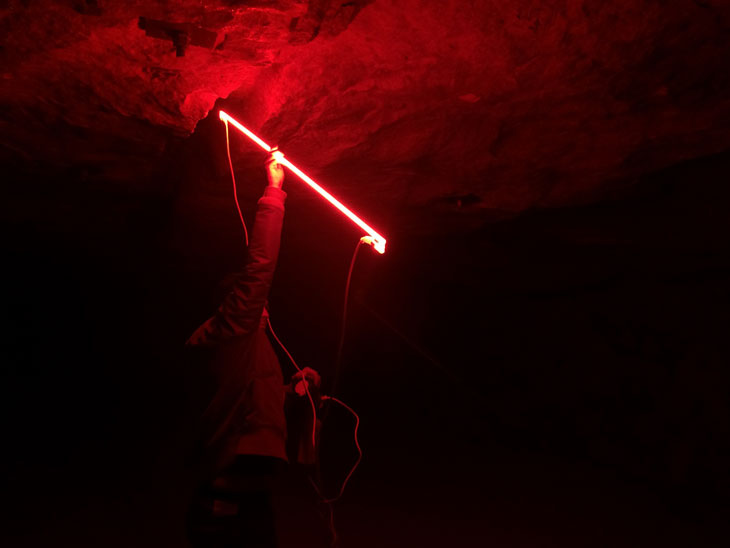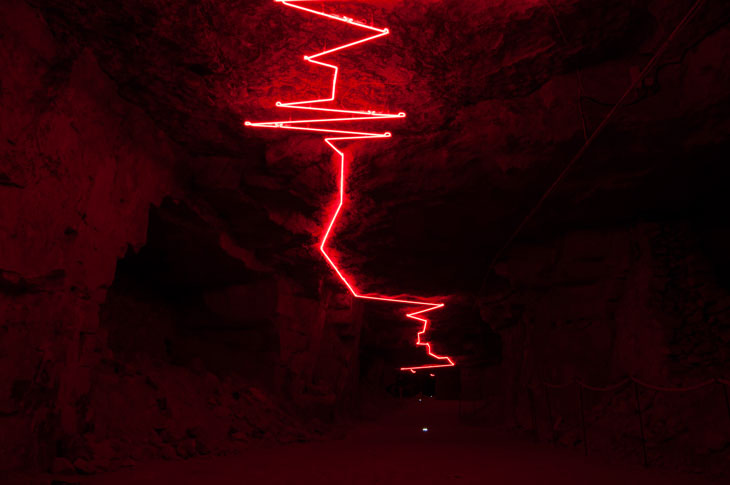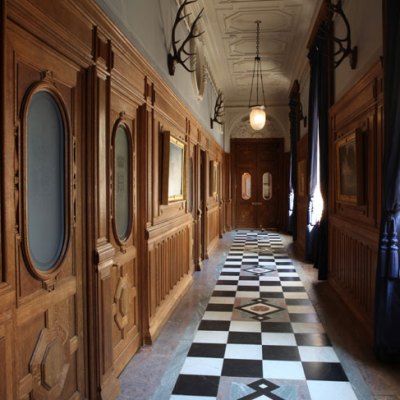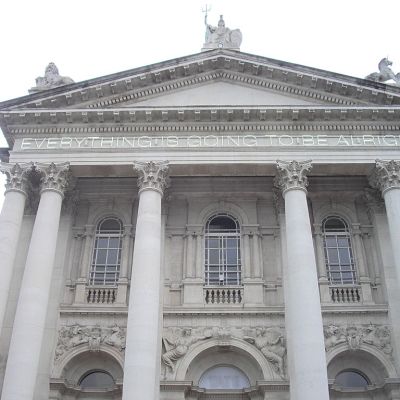How do you turn a place into a destination when that which originally gave it value has been removed? One answer is contemporary art. This is the approach now being adopted by Maison de la Pierre, a heritage site in a former quarry in Saint-Maximin, in the department of L’Oise, about an hour’s drive north of Paris. Last month saw the public opening of the museum’s new Galerie Rouge, a cavernous, 500-square-metre space located underground, inside the 16th-century stone quarries. The ultimate aim is to bring together contemporary art with digital technology and the historic techniques of stone miners and masons. The complete displays have yet to be realised, but a permanent site-specific installation in red neon by French artist Christian Delécluse is a promising beginning.
Maison de la Pierre opened in 2014, and tells the story of its site – a combination of geology and human history. Today, the museum is a fun, family-friendly place, with an education space, a large, well-equipped sculpture and masonry studio, a shop, outdoor courtyard and – rather incongruously perhaps – a mini farm with rabbits and chickens.
Maison de la Pierre. © Comdesimages-B. Tesseidre

But it is upon walking into the tunnel of the former quarry that things really come to life. Forty-five million years ago, this entire region was under the ocean. Skeletal fragments from marine organisms settled on the sea bed, and with pressure and sufficient time, became compressed to form the mass of limestone that extends across the entire geological basin of Paris. The deepest deposits of this limestone are soft and permeable; those close to the surface hard and waterproof. It has been quarried since Gallo-Roman times. In the middle ages stone began to replace wood for important structures, but it was not until the 17th century that the limestone from Saint-Maximin became famous. Simple to work with, durable, and easily transported to the capital (the river Oise connects with the Seine at Conflans-Sainte-Honorine, a north-western suburb of Paris) this limestone was a natural choice for architects. It is from the stone of this region that some of Paris’s great landmarks were constructed: the Pont-Neuf, Place des Vosges, and Place de la Concorde to name just a few.
Gradually, however, as concrete and steel became the materials of choice for architects and developers this key regional industry began to fade. Mechanisation has decimated jobs. Today, just a handful of the region’s quarries survive. Nonetheless, the limestone of Saint-Maximin remains highly valued – and not only in Paris. Stone from the region has been used in constructions as far afield as Nevada and Stanford University in California. The clay used for the Roland-Garros tennis courts comes from Saint-Maximin too.
Installation of Christian Delécluse’s neon art in the Galerie rouge at Maison de la Pierre

Disused industrial sites have long proved fertile ground for art and culture. But Maison de la Pierre is a little different: French mining company Rocamat still runs an open quarry of some 50 hectares on another part of the site. Before becoming Maison de la Pierre, the quarry was used as a bomb shelter during the Second World War and more recently for the commercial growing of mushrooms. Short films and sound-and-light shows tell these stories within the quarries, but these and future displays face a persistent dilemma. A quarry is a place of extraction and consequently a site of absence. The site’s cultural significance derives in large part from the uses of its stone: what’s left behind is an empty space. Maison de la Pierre’s caverns have none of the grandeur of Istanbul’s ancient cisterns, for example, nor the archaeological fascination of underground Naples. They need bringing to life in more imaginative ways.
This is where Christian Delécluse’s new installation shines. The work consists of 150 metres of red neon lights that stretch throughout the newly inaugurated Galerie Rouge. Delécluse emphasises the handmade nature of the piece: instead of industrially produced neon, the artist has worked closely with artisan glassmakers in France who blow and shape each piece by hand. The production is painstaking, the installation just as delicate, for this is no white cube gallery but a rough-hewn place of industry. ‘Rien est droit,’ said Delécluse at the opening. ‘Rien est pur.’ (‘Nothing is straight. Nothing is pure.’)
Christian Delécluse’s installation in the Galerie rouge at Maison de la Pierre

This is just the beginning of Maison de la Pierre’s new project. Next year will see the launch of ‘Vibrations Souterraines’, a festival combining contemporary art with traditional craft and digital technologies across both Galerie Rouge and the rest of the museum. Like the mining techniques of old, Delécluse’s red neon responds to fissures in the rock, scribbling back and forth like a seismogram above our heads. The work therefore traces pre-existing lines in the rock, the products of aeons of geological development and centuries of human history, and at the same time lights a path for the visitor and for future artworks to come.
For more information on Maison de la Pierre, visit the centre’s website.


